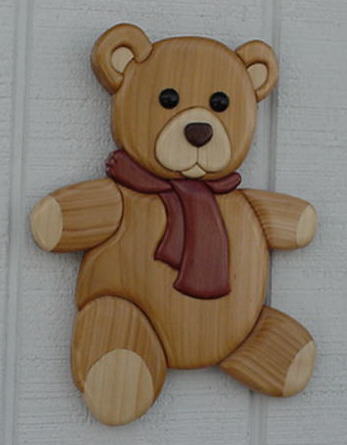Chapter 6 - Finishing
There are scores of wood finishes on the market, but little agreement among intarsians as to which is best. Each of us has his or her favorite. We extol its virtues in discussion groups, and generally love it to death. Then one day we get sick of it and switch to something else.
Here’s a list of popular wood finishes, along with their virtues and vices.
Gel stains: Not used in intarsia, as they alter the color of the wood.
Wiping- and brush-applied finishes: This group includes Bartley’s wiping gel and similar products, plus all the standard cans of varnish and polyurethane that line Home Depot’s shelves.
There are some excellent products here. Many intarsians use them. But some of us find it difficult to apply even coats to intarsia projects, with all their nooks and crannies. Hand application is also time-consuming.
Some intarsians apply even coats by finishing the individual intarsia parts before gluing them to the backboard. This definitely works. But the process is even more time-consuming, to the tune of whole days.
Oil-based sprays: This group includes spray cans of various varnishes and polyurethanes. Generally, these products spray a fine mist, so getting an even coat is a cinch. While drying, they level themselves very well. The resulting finish is smooth and even.
Oil-based finishes are at their best on darker woods such as walnut and cherry. Oil deepens and intensifies the color, resulting in a richness no other finish can match.
But oil has its drawbacks. One is the lengthy drying time, six hours minimum. This gives dust a chance to settle on your work. Also, building up three or four coats of finish can take longer than it took to build the piece in the first place.
A more serious drawback is ambering. Ambering is the tendency of oil-based finishes to darken or yellow light-colored wood. The effect can be disastrous. I once built two very nice snowmen and finished them with spray poly. In a month they looked as if they had been built them from yellow snow.
Getting whites that are truly white is something of a problem in intarsia anyway. Holly, said to be the whitest of woods, is both expensive and hard to find. Aspen is never as white as one would wish, and works and finishes poorly besides. Most basswood is cream-colored. Other woods, among them maple and poplar, can be found in white phases, but just how truly white they are is uncertain. What you see is what you get.
In an effort to produce white that is white, many intarsians who never use stains ... use stains. Minwax pickled oak or Bartley’s intarsia whiting applied to light-colored wood is very effective. But stains are no defense against ambering. There is no defense against ambering.
Water-based sprays: The enormous virtue of water-based sprays such as Varathane and Polycrylic is that they do not amber. Colors, including white, remain true. Though expensive, these products level well, and drying time is a short two hours.
The vice of water-based sprays is that they raise the grain of the wood. This means sanding, perhaps a lot of sanding, between coats. Intarsia projects, with their nooks and crannies, do not sand easily. Even so, water-based sprays are the choice of many intarsians.
Lacquer-based sprays: In this category are products with long lists of chemicals and warnings about birth defects on the label. They emit fumes that bite your eyes. Nice stuff.
Lacquer does not amber. It does not raise the grain of the wood. It dries in about thirty minutes. That’s three big plus-marks.
Unhappily, lacquer seems to be available only in matte or gloss finishes (Deft offers a semi-gloss, but to my eye it is matte). Matte finish is too dull for many tastes. And gloss has a thin, glittery appearance better suited to costume jewelry than fine woodworking.
What to do?
Lately I’ve been spraying two coats of gloss lacquer to seal the wood. The project is then rubbed out with fine synthetic steel wool and top-coated with spray semi-gloss Polycrylic. The water in the Poly cannot get through the lacquer, so it does not raise the grain. Today, this is the best finish world. I don’t know about tomorrow.
What shall we do with Teddy? Apply the finish of your choice.

Teddy finished in lacquer top-coated with semi-gloss Polycrylic.